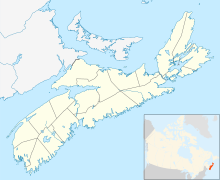Stewiacke East in Nova Scotia
East Stewiacke is a community in the Canadian province of Nova Scotia, located in Colchester County. It is mainly a farming and rural bedroom community, neighboured by the communities of Mackay Siding, West St Andrews, Alton and The Town of Stewiacke.
It is home to the Stewiacke River Park, on the Stewiacke River.
45°8′38″N63°17′49″W / 45.14389°N 63.29694°W

